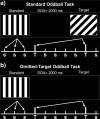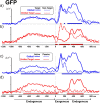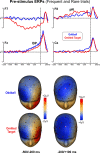"Hit the missing stimulus". A simultaneous EEG-fMRI study to localize the generators of endogenous ERPs in an omitted target paradigm
- PMID: 30842443
- PMCID: PMC6403295
- DOI: 10.1038/s41598-019-39812-z
"Hit the missing stimulus". A simultaneous EEG-fMRI study to localize the generators of endogenous ERPs in an omitted target paradigm
Abstract
Event-Related Potentials (ERPs) occurring independently from any stimulus are purely endogenous (emitted potentials) and their neural generators can be unequivocally linked with cognitive processes. In the present study, the subjects performed two similar visual counting tasks: a standard two-stimulus oddball, and an omitted-target oddball task, characterized by the physical absence of the target stimulus. Our investigation aimed at localizing the neural sources of the scalp-recorded endogenous/emitted ERPs. To optimize the source localization, the high temporal resolution of electrophysiology was combined with the fine spatial information provided by the simultaneous recording of functional magnetic resonance (fMRI). Both tasks identified two endogenous ERP components in the 300 to 520 ms interval. An earlier component, pP2, showed a bilateral generator in the anterior Insula. A later P3 component (P3b) was generated bilaterally in the temporal-parietal junction, the premotor and motor area and the anterior intraparietal sulcus (this latter one only in the standard oddball). Anticipatory slow waves (beginning 900 to 500 ms pre-stimulus), also of endogenous nature, were produced by the inferior and middle frontal gyrus and the supplementary and cingulate motor areas. Our protocol disentangled pre- from post-stimulus fMRI activations and provided original clues to the psychophysiological interpretation of emitted/endogenous ERPs.
Conflict of interest statement
The authors declare no competing interests.
Figures







References
-
- Sutton S, Tueting P, Zubin J, John ER. Information delivery and the sensory evoked potential. Science. 1967;155:1436–1439. - PubMed
-
- O’Connell RG, Dockree PM, Kelly SP. A supramodal accumulation-to-bound signal that determines perceptual decisions in humans. Nature Neuroscience. 2012;15:1729–1735. - PubMed
-
- Picton TW, et al. Guidelines for using human event-related potentials to study cognition. Psychophysiology. 2000;37:127–152. - PubMed
-
- Duncan CC, et al. Event-related potentials in clinical research: Guidelines for eliciting, recording, and quantifying mismatch negativity, P300 and N400. Clin. Neurophysiol. 2009;120:1883–1908. - PubMed

